Located at the meeting place of the Mo Chhu and Pho Chhu rivers in the lush and fertile Punakha Valley, the city of Punakha is the former capital of Bhutan. This picturesque city of 6,262 residents served as the national capital until 1955, until the capital was moved 72 km southwest to Thimphu. As Bhutan’s second-largest city, the top things travelers must see and do in Punakha, Bhutan are quite varied. They take advantage of the city’s location, as well as its unique culture and history.
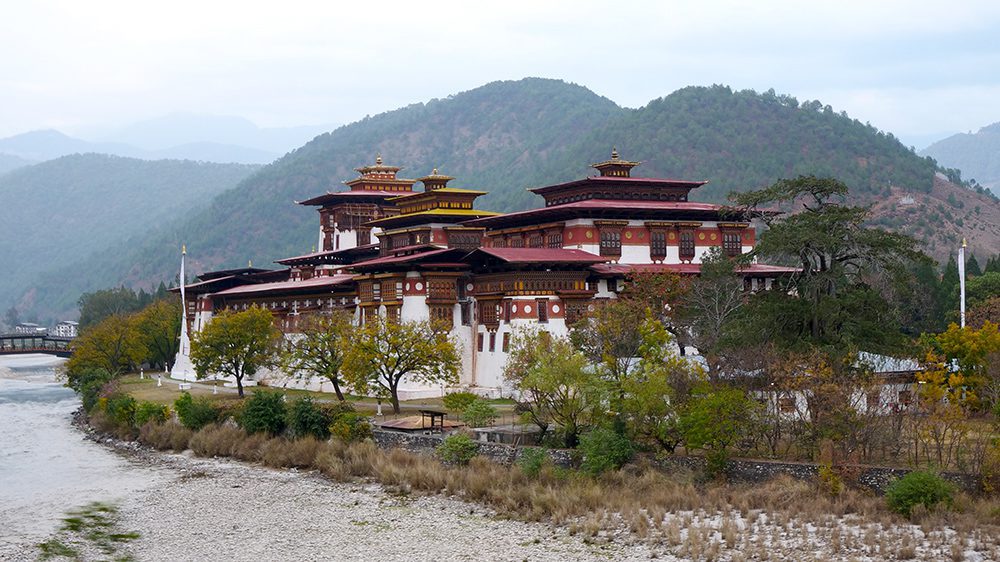 The city lies just 1,250 meters, or 4,100 feet, above sea level, so it enjoys a much warmer climate than other parts of the country. When I visited the city with my guides from MyBhutan in early March of 2020, I was surprised at just how warm it was at times. In addition to the physical warmth, the warmth was also quite figurative. Even though my trip coincided with the country’s first case of COVID-19, the locals were extremely kind and welcoming. They still seemed to go the extra length to ensure that I had a great time.
The city lies just 1,250 meters, or 4,100 feet, above sea level, so it enjoys a much warmer climate than other parts of the country. When I visited the city with my guides from MyBhutan in early March of 2020, I was surprised at just how warm it was at times. In addition to the physical warmth, the warmth was also quite figurative. Even though my trip coincided with the country’s first case of COVID-19, the locals were extremely kind and welcoming. They still seemed to go the extra length to ensure that I had a great time.
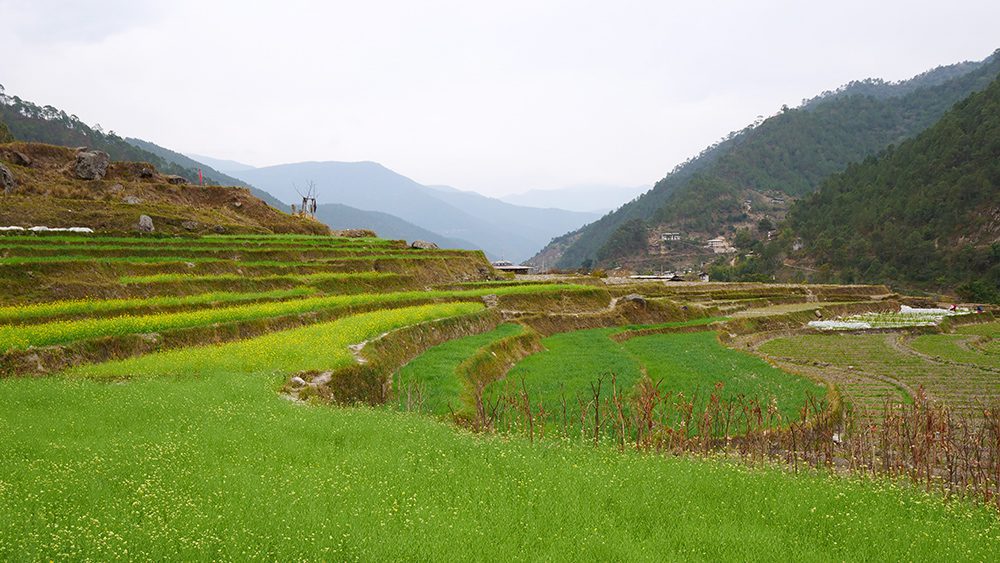
My days in Punakha were a true treat. I got to dive into the beautiful world of Bhutanese Buddhism, which is steeped in tales of magic and mysticism. I had the pleasure of exploring local villages to get a real taste of what life in Bhutan is like. My taste buds were fully immersed, as mealtimes were a revolving door of Bhutan’s most traditional dishes. I urge you to experience them all on your next Bhutanese adventure. These are the top 10 things you must see and do in Punakha, Bhutan.
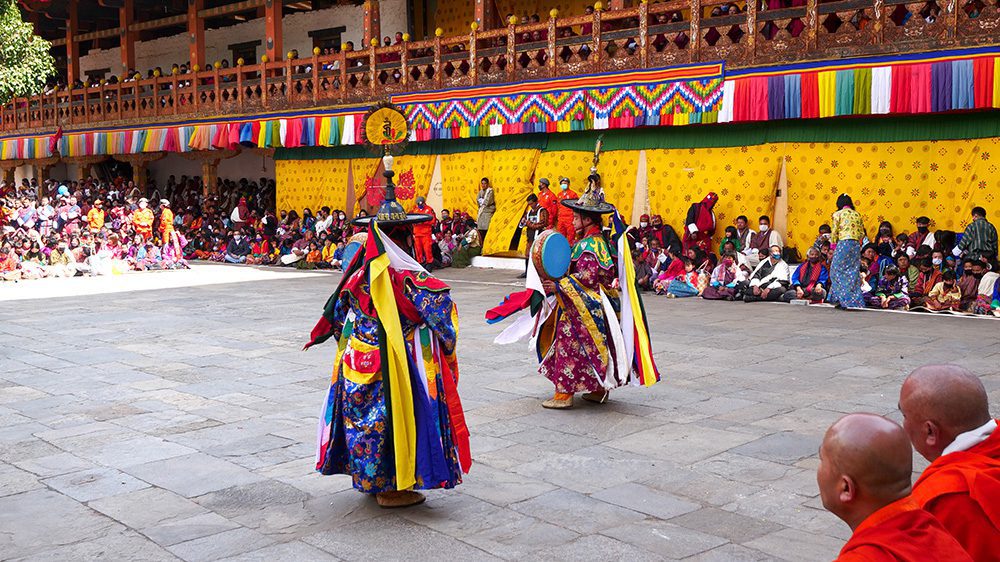
I arrived in Punakha on March 5, 2020, just in time to catch the end of the festival’s opening day. The six-day-long festival takes place at the beautiful Punakha Dzong Pungthang Dechen Phodrang, which was built by the unifier of Bhutan, Ngawang Namgyal, between 1637 and 1638. Better known as Punakha Dzong, It’s the second-largest dzong, or fortress, in Bhutan. It was built as an “embodiment of Buddhist values.” Inside the dzong are sacred relics and the sacred remains of Ngawang Namgyal and the Bhutanese saint Pema Lingpa.
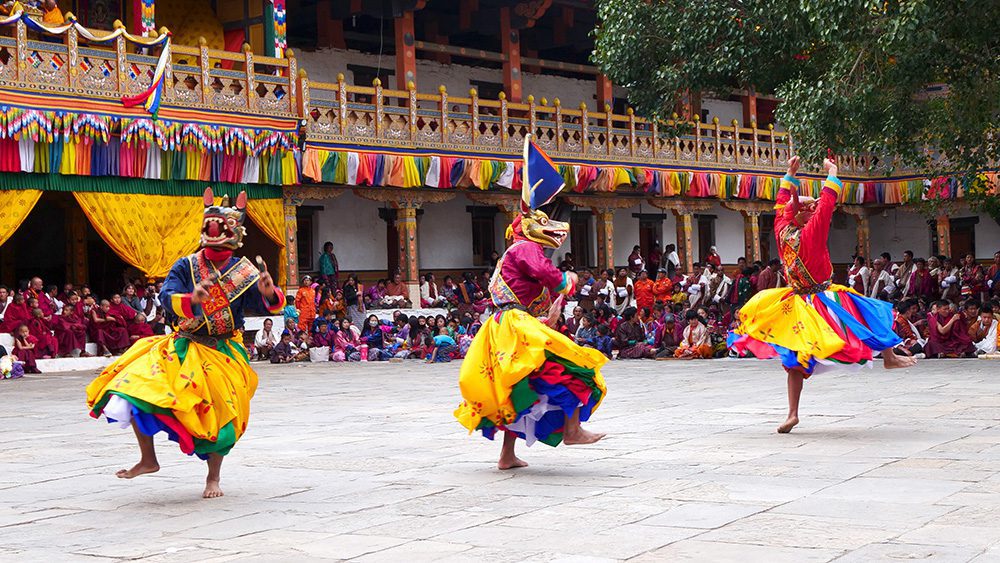
During my two days there, thousands of spectators and I were treated to several performances in the dzong’s courtyard. The performances featured dancers and actors wearing intricate, colorful clothing and masks that represent animals. The dance- and music-heavy performances told stories about the founding of the fortress, non-violence, Buddhism, and much more. They were quite beautiful!
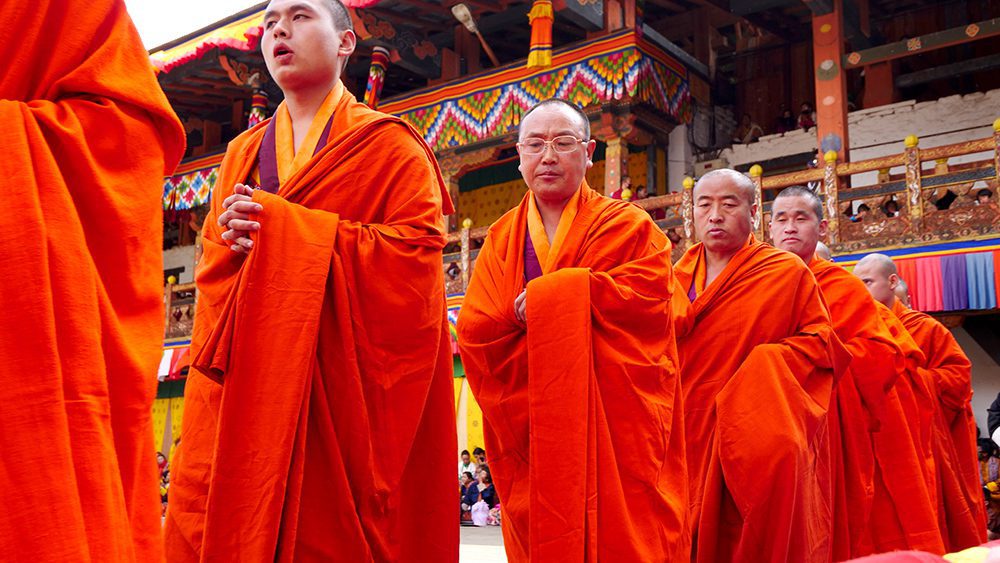
If you want to visit the festival, you must get there early, as it starts at 9 a.m. They close the doors to the fortress at 10 a.m. and don’t reopen them for several hours, so you’ll miss it if you’re not there on time. Getting there early will also increase your chances of getting a good seat!

Elsewhere inside the fortress is a large and ornate prayer wheel, which you spin to gain merit. The dzong is also home to a large monastic area that houses between 400 and 500 monks. Punakha Dzong is also a fantastic place to admire traditional Bhutanese architecture. It uses lots of bright, vibrant colors.
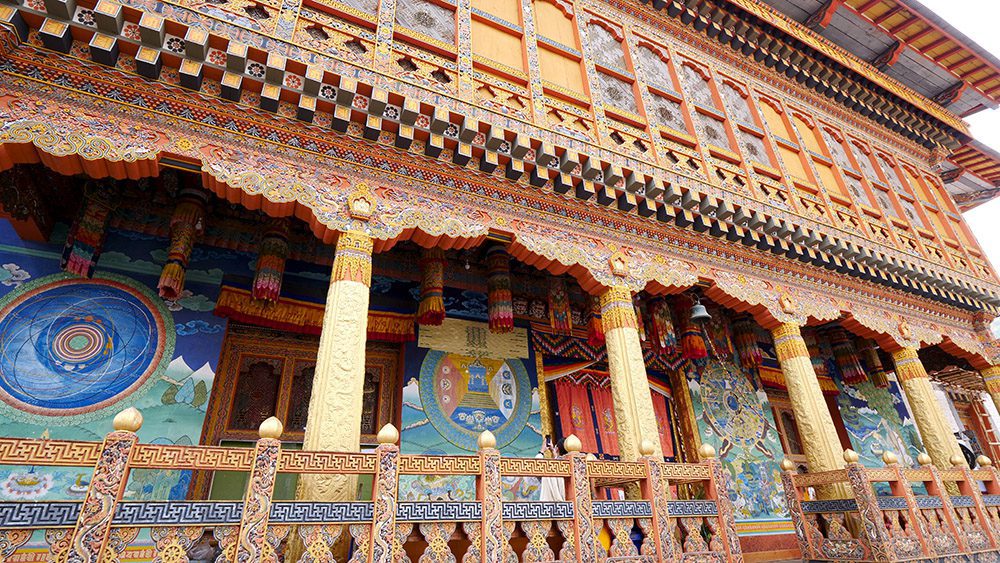
Be sure to admire the paintings and carvings of snow lions, dragons, and other animals throughout the complex. There’s also a set of golden doors, through which they coronated Bhutan’s first king in December of 1907. You can also visit the shrine and temple across the complex from the residential area. Just remember, you cannot film or take photos in either.

Because Punakha lies at the confluence of two rivers, the locals use bridges to get across them. One of them, the Punakha Suspension Bridge, spans the width of the Pho Chhu River, which is also known as the Male River. It’s 160 meters long and is one of the world’s oldest suspension bridges. It is believed the bridge was built by a Buddhist monk named Thangtong Gyalpo.

At the entrances to the bridge, don’t be surprised if you find locals playing games and gambling. Because the bridge is a tourist attraction, you’ll likely also find locals selling snacks there.
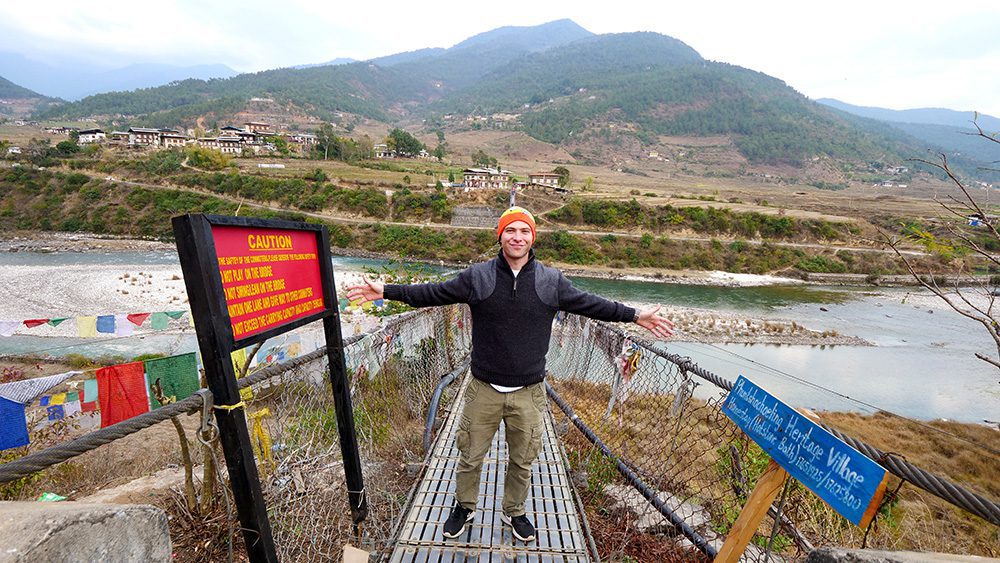
The bridge itself spans high above the shallow river and is draped in hundreds of colorful prayer flags. It wobbles and shakes as you and others walk across it, which is a bit scary, but the view of the valley and the river below is worth it. The air quality is also incredible, as Bhutan is a carbon-negative country!
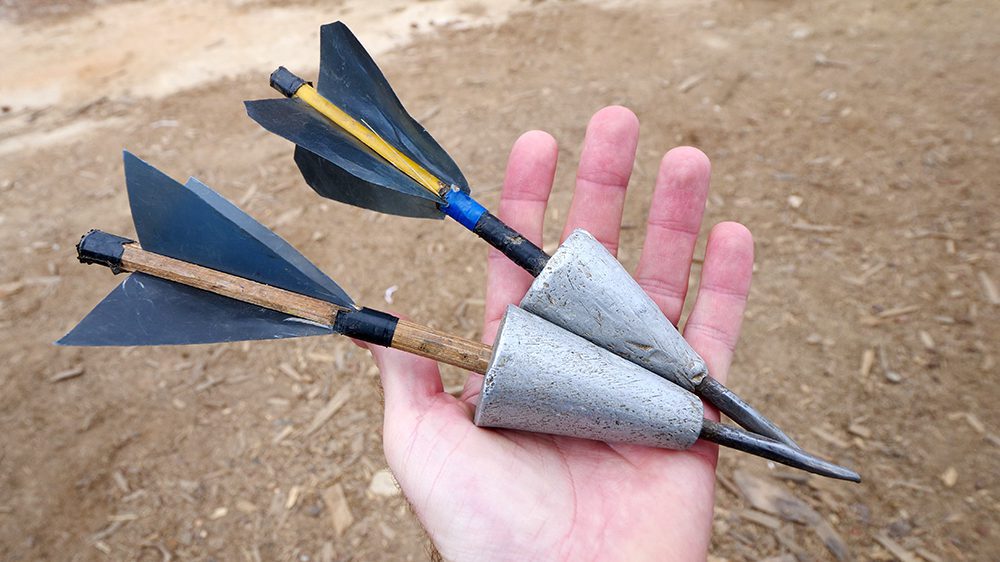
On the other side of the bridge from Punakha Dzong, you’ll find locals playing a game using large darts. For 50 Ngultrum (better known as Nu)/$0.66 USD, you can throw two darts at a target. If you hit the target, you win 100 Nu ($1.32 USD). It looks easier than it actually is—I tried a few times but I just didn’t have any luck that day!
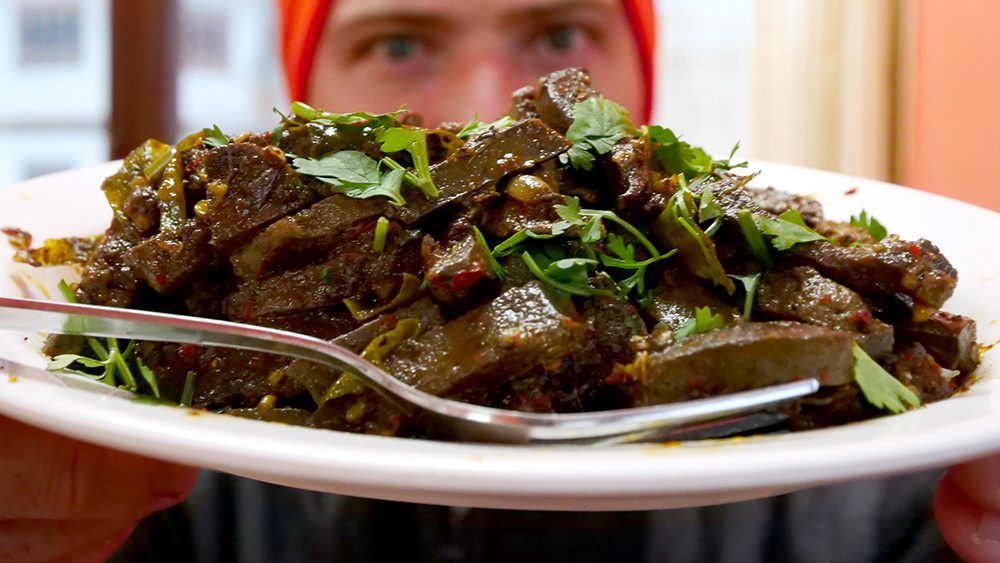
In a lot of parts of the world, it’s common to find restaurants that also have bars. But in Bhutan, it’s a little different. The government stopped issuing bar licenses to restaurants, so finding restaurants that have bars can be pretty difficult. One such restaurant can be found in a nondescript building in the downtown area.

You either have to know where it is in order to find it, or really look hard, because it’s well off the beaten path. It’s worth it if you’re looking for a nice brew, as you can find a tasty 650 mL Druk 11,000 there. It’s 8% alcohol and is comparable to the Kingfisher Strong you can find in India.

The beer pairs nicely with the must-have dish on their menu, spicy liver with chilies and peppers. The liver is buttery and melts in your mouth. But it’s also very spicy, like much of the food in Bhutan. This liver contains numbing spices, much like some of the Szechwan food I ate in China. The spices numbed my lips and my tongue, but not so much that I couldn’t taste how fantastic the liver was. It’s one of my favorite liver dishes of all time and among my top eats in Punakha, Bhutan!
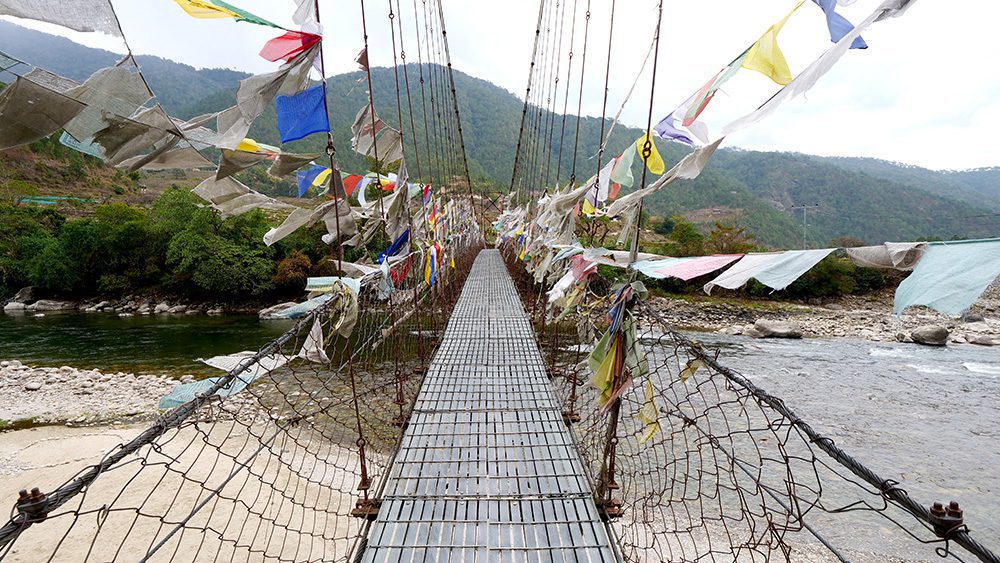
If you truly want to experience the culture in Bhutan, you’ll have to get in shape! Hiking is the main way to reach many of the country’s cultural and religious sites, including Khamsum Yulley Namgyal chorten. This monastery was built by the current king’s mother to protect Bhutan and to spread peace and harmony to the world.
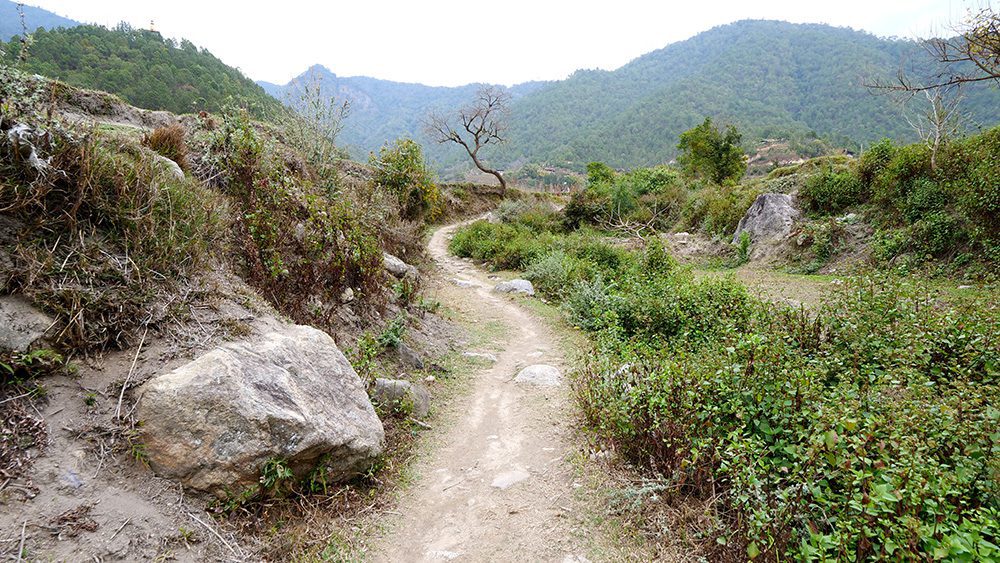
I suggest being moderately fit to attempt this hike, which takes about 40 minutes. This experience is one of the top attractions in Punakha, Bhutan, so I suggest going for it. You’ll start by crossing a prayer-flag draped suspension bridge over the Mo Chhu River. A rocky trail on the opposite bank will take you past rice paddies, chili fields, a spring, and a prayer wheel. If you need assistance on the trail, there is a stand where you can buy or rent a walking stick.
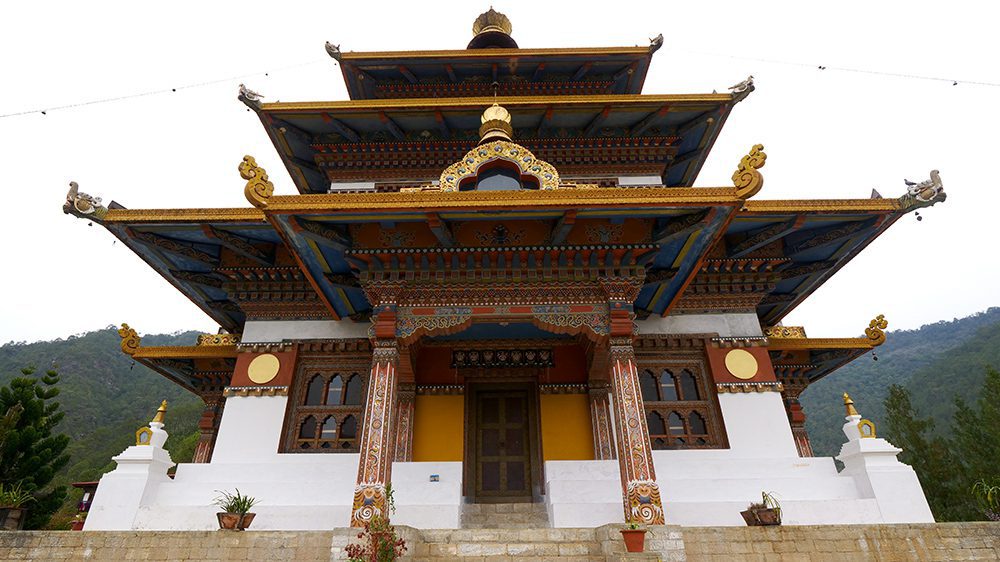
Beyond that is a staircase that leads to Khamsum Yulley Namgyal chorten. Keep in mind that you must remove your shoes and hat before you go inside. Filming inside the monastery is also forbidden, but you can still admire the architecture and the colorful paintings on the walls.
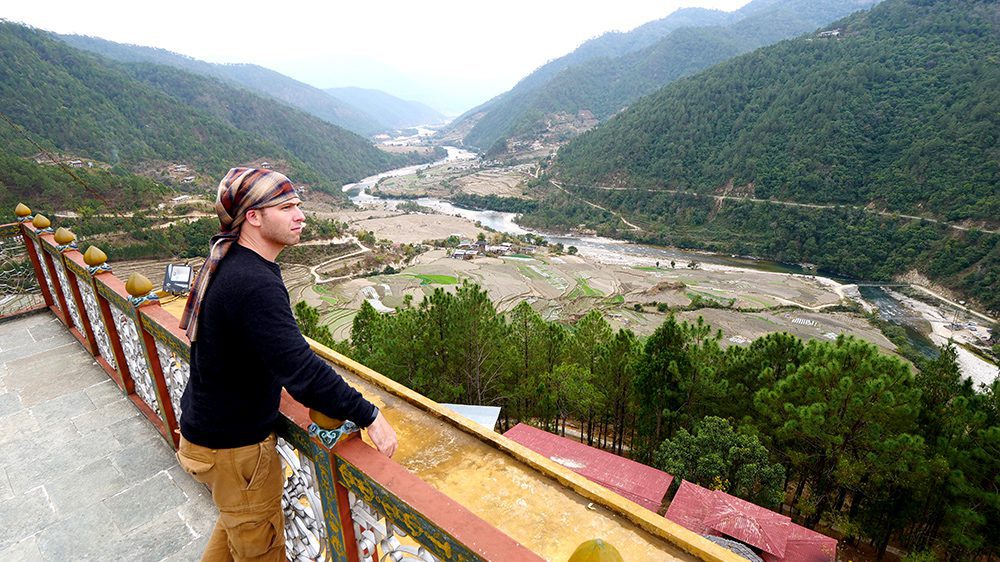
On each floor of the monastery are statues of deities. There are a lot of them on the first floor. After you climb up three floors, you’ll reach the roof of the monastery. The rooftop offers unparalleled views of the Punakha Valley. You’ll be able to admire the river, distant rice paddy fields, and a white tea house that hosts the royal family. There’s also a golden stupa there, and you can also get a good look at the trail you took to reach the monastery!

As you make your way down from Khamsum Yulley Namgyal chorten, you’ll approach a small hut. The hut may not look like much on the outside, but it’s actually a mini-market, almost like a convenience store. But here, they sell some locally-made spirits, including whiskey and brandy.
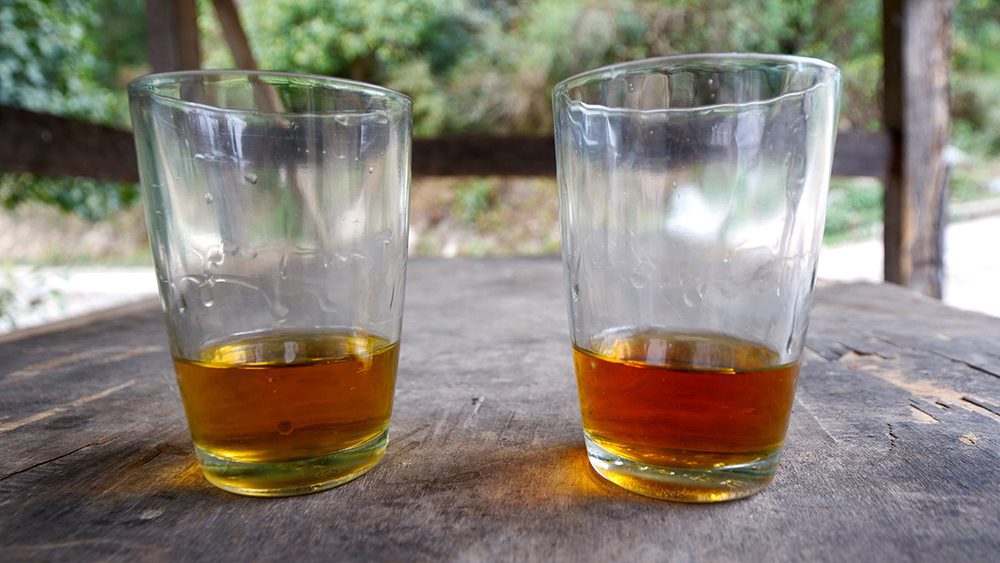
I suggest trying the Essence of the Himalayas Bhutan Grain whiskey and the Rock Bee Blended Grape brandy. I had a shot of both, which cost me 40 Nu/$0.53 USD each. Both are quite strong, but the whiskey wasn’t too potent. The brandy had a fruity flavor and quite a potent kick. I must admit, I didn’t love either, but it was great to taste some locally-produced alcohol. But if, like me, you’re all about trying the local food and spirits, it’s one of the things you must do in Punakha, Bhutan!
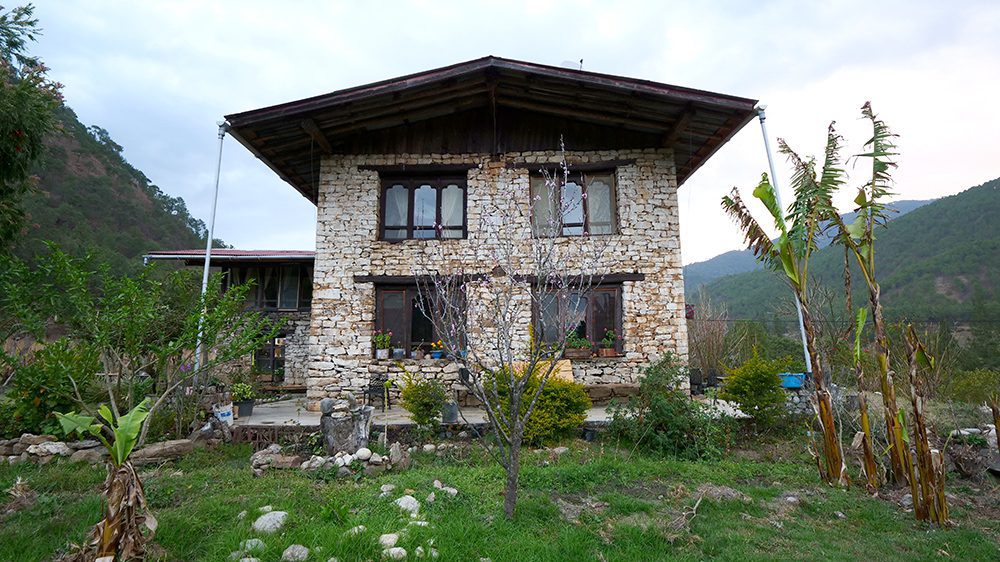
During your time in Punakha, you could easily stay at a hotel, but if you want an authentic experience, I suggest spending the night at a homestay. In particular, the Happiness Field Village Homestay, which is located across yet another suspension bridge. The property is quite secure, as the bridge is guarded by a locked gate surrounded by barbed wire.
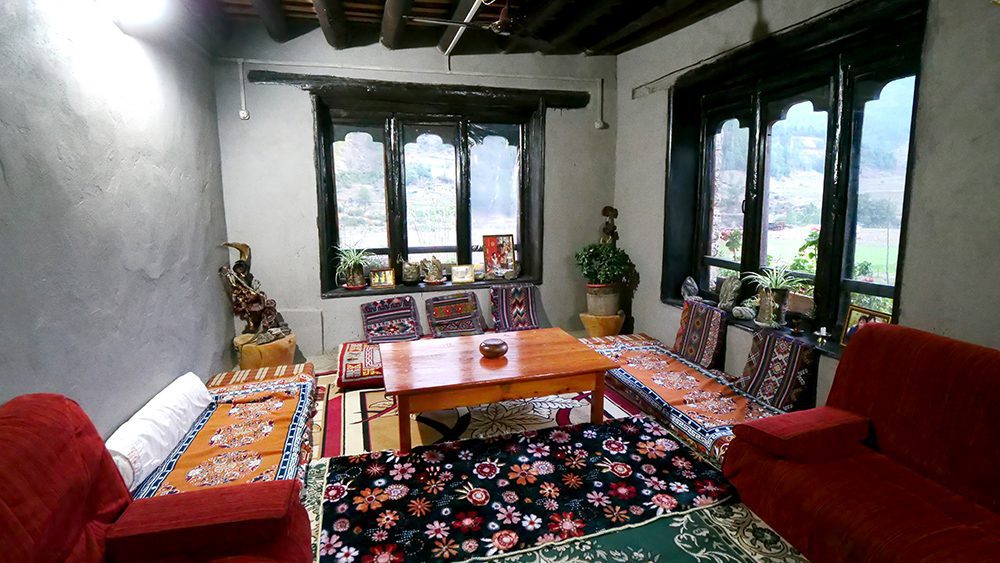
If you’re looking to truly immerse yourself in the Bhutanese way of life, this is the place to do it. The woman who cooks the homestay’s food prepared a traditional Bhutanese dinner of chicken curry; ema datshi (the national dish, which is made of spicy chilies and cheese); stir-fried spinach with tomatoes, chilies, red peppers, onions, and garlic; red rice; a rice wine called ara that contains butter and eggs; and more!
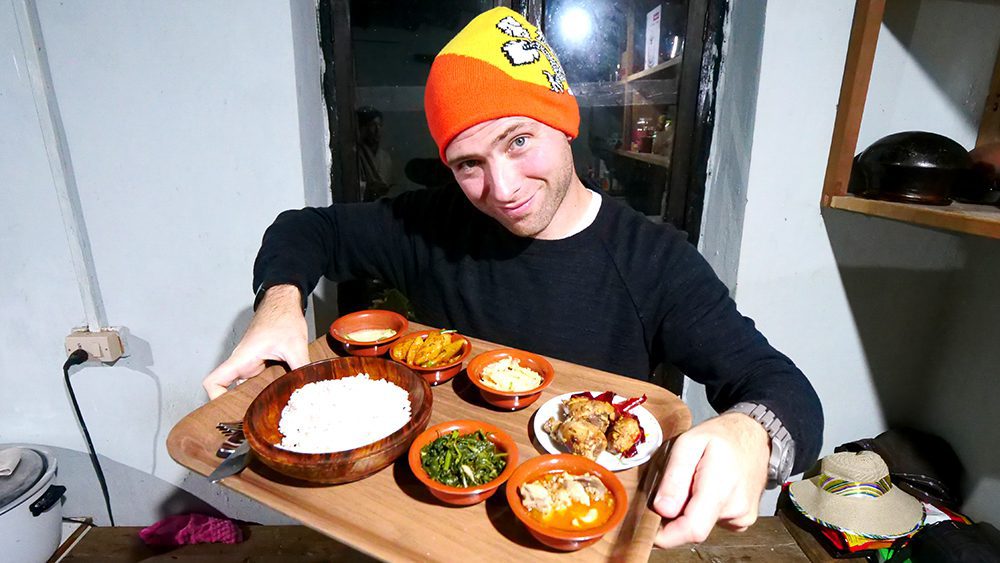
The buttery ara is very unique and quite strong and has a taste similar to Japanese sake. If it’s a bit too extreme for you, they also have ara without the butter and egg. I admit, liked that version a lot more. Surprisingly, one of the highlights of the meal for me was the spicy cucumber salad with coriander and fresh cow cheese. I usually don’t like cucumbers, but this one was really special! I also enjoyed the chicken with chilies, which was bursting with flavor. Even the stir-fried spinach left a spicy tingle on my lips. It was my favorite of the night!
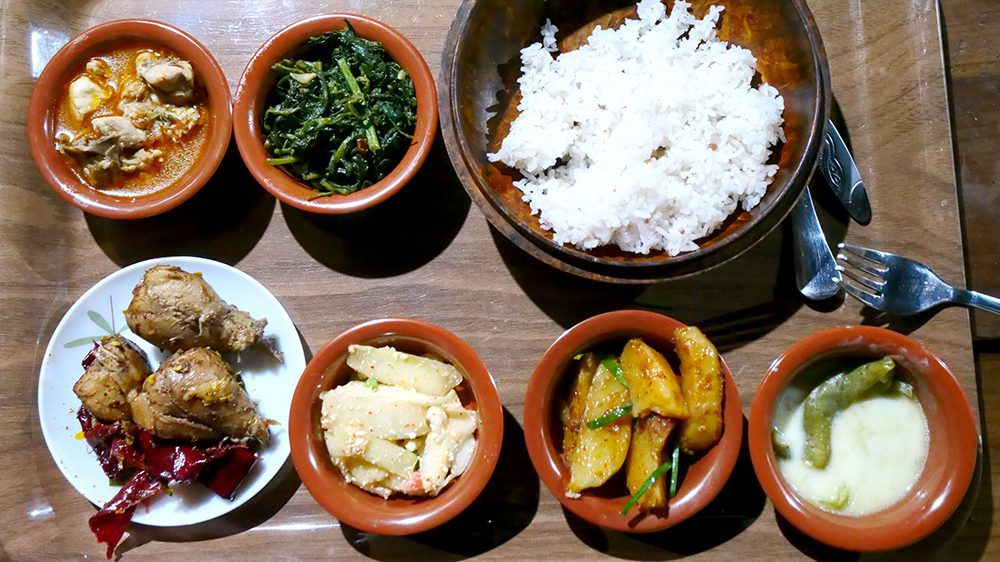
One dish you’ll see everywhere in Bhutan is ema datshi. This Bhutanese specialty consists of chilies coated in a creamy cheese sauce made from yak milk. The dish is often very spicy, especially at restaurants that don’t cater to a Western palate. This kind was comparatively mild but still left a fiery sensation that lingered on my tongue.
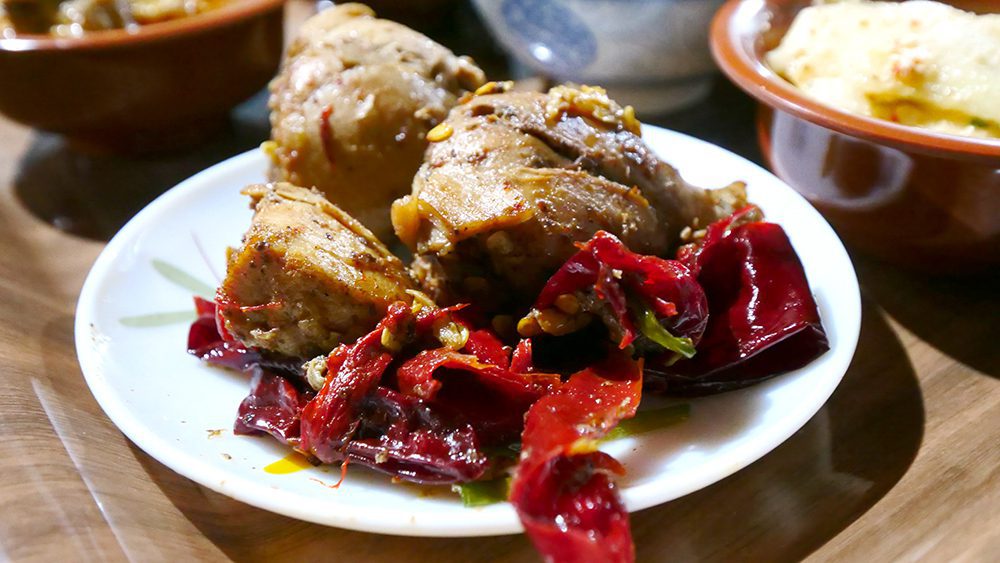
All of the food served in Bhutan is organic and fresh, and the high quality of the ingredients can also be found in the homestay’s breakfast menu. In the morning, I recommend trying a simple rice porridge with fried rice and a spicy chili salsa called ezay. The porridge is creamy but neutral, so I suggest adding some of the ezay to it to give it a kick. The fried rice is also creamy and sticky, so it’s like a cross between risotto and fried rice. It contains long beans, chilies, and onions, and is definitely on the hot side! If it gets too hot, try some gingery ngaja, or milk tea. The milk will help put out the fire in your mouth!

Hands down, one of the top things you must see and do in Punakha, Bhutan, is visit the village of Sopsokha. This village of less than 1,000 has gained quite a bit of notoriety in recent years for its unique décor choices. In this small hamlet, every home and restaurant has paintings of penises on their outer walls!
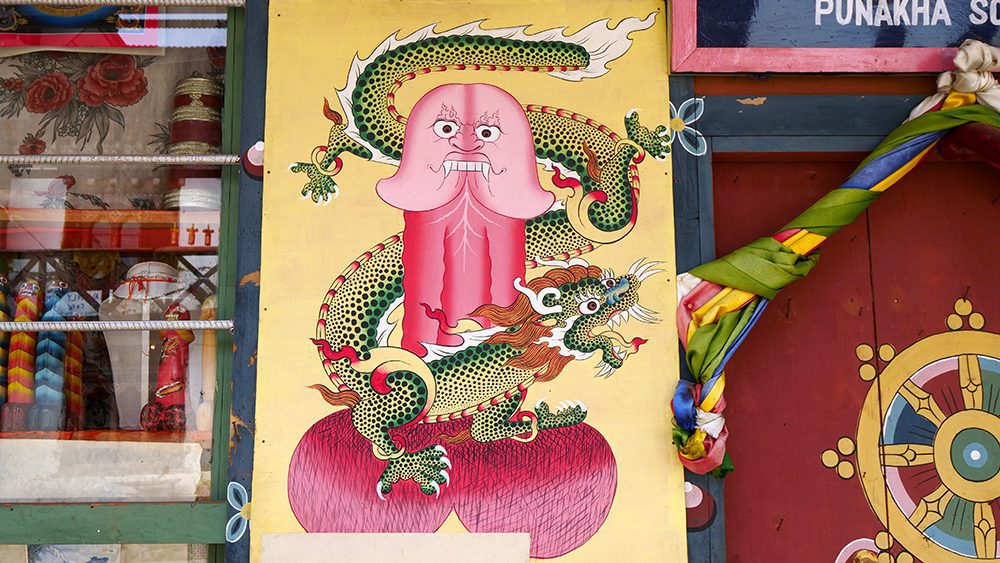
Yes, that’s right. In Sopsokha, you can find a number of penises painted on the walls of homes and businesses. The phallic symbols range in color and appearance—some are more whimsical while others are quite scary-looking. Most of them have eyes and a few even have fangs and full faces!

After you get over the initial shock of seeing penises casually splashed across local buildings, you’ll learn that there’s a reason for them. The nearby Chimi Lhakhang Monastery was established by Lam Drukpa Kuenley, a Buddhist master known as the “Divine Madman.” He was known for his off-color lifestyle and teaching techniques.
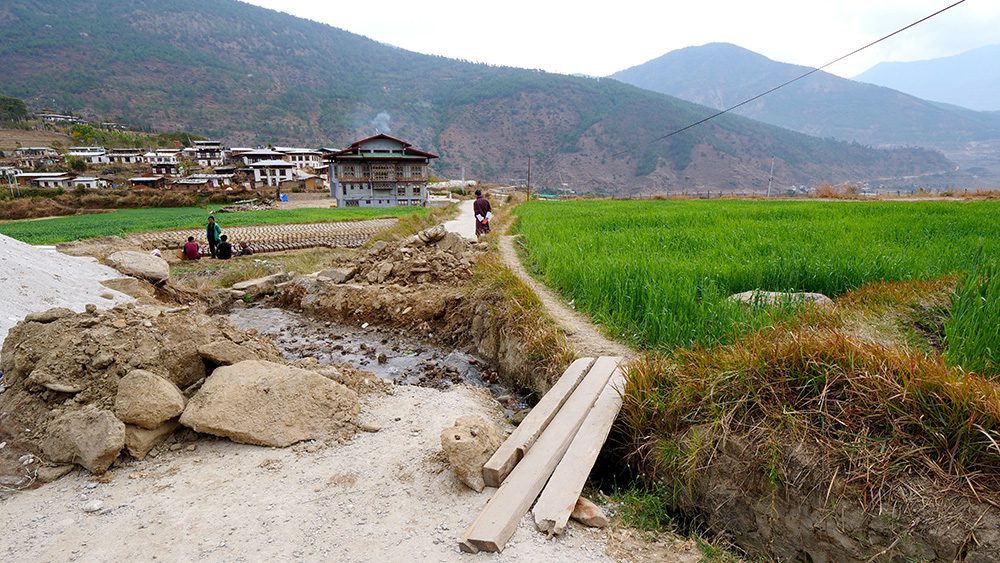
According to legend, he used his penis to subdue and fight off evil spirits that arrived in the town. Ever since, locals have painted phallic symbols on their homes and businesses to ward off evil spirits. It’s also a sign of fertility.

Sopsokha is divided into several parts by rice paddy fields. Throughout the town are numerous shops that sell wooden phalluses in a variety of colors. Some are plain, while others are quite extravagant and painted with bright, vibrant colors. My personal favorite was a black-and-red one with a dragon wrapped around it! If you’re not interested in buying one, they also sell paintings, prayer beads, scarves, and traditional masks. The masks cost around 1,500 Nu/$19.84 USD.

As you leave the Sopsokha behind, you’ll find a black stupa. This is where the Divine Madman is said to have subdued a demonic black dog consisting of the demon of Sopsokha and the demon of Dochula. You’ll also find a large prayer wheel and 108 smaller ones. Prayers may be in session when you visit, so please be quiet and respectful. As always, you must remove your shoes inside. You also cannot film inside the shrine or in any of the holy areas.
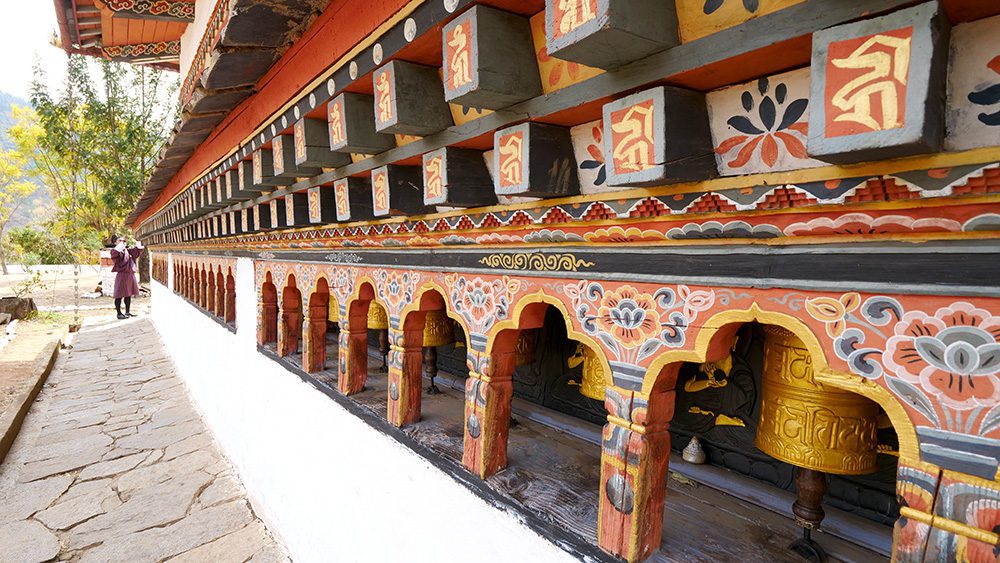
You’ll also likely hear music and chanting at the monastery. You may also see young children training to become monks. Here, children begin their training at the age of six. The decision is made by their parents, and any child whose parents choose this will be a monk for life. It’s a fascinating look at Bhutanese life and one of my favorite things to see and do in Punakha, Bhutan.

Back in the village, you can have a traditional lunch at the Chimi Lhakhang Organic Café. This rustic, eye-pleasing eatery offers stunning views of the surrounding rice paddy fields, the village, and the mountains. In addition to traditional Bhutanese fare, you can also buy wooden bowls, containers for storing ara, and locally-made scarves.

I suggest trying their 5% Druk lager, a light and refreshing beer with a crafty taste. Then, I recommend their ema datshi, red rice, dried pork with spinach and chilies, dried beef sausage with chilies, and vegetable soup.
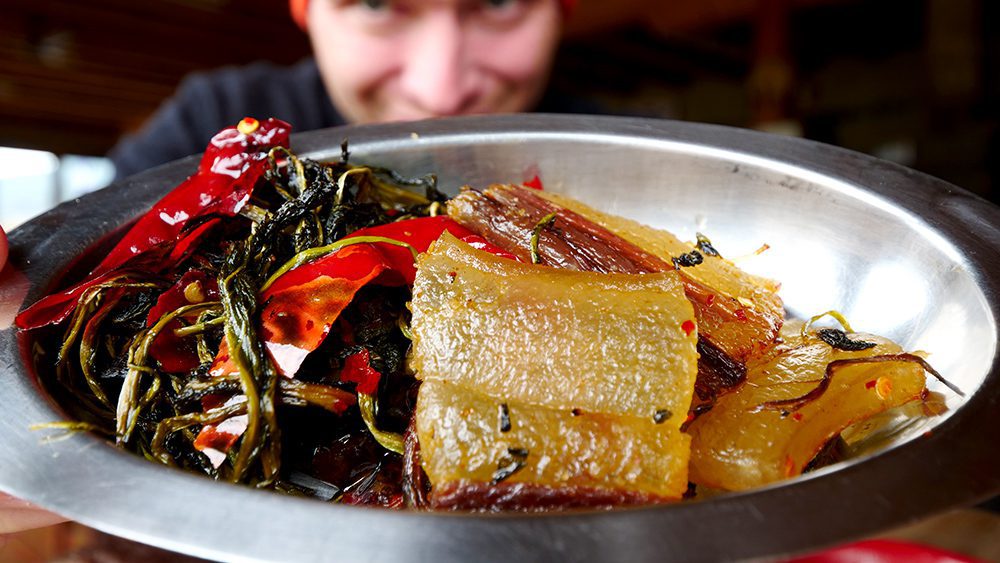
The ema datshi contains extremely spicy green chilies as well as milder red ones and mushrooms. Eat it with the red rice to temper the heat. The rice also goes well with the beef sausage, which contains chili oil and chili seeds. Try them with the ezay provided on the side. The vegetable soup is light and cloudy and contains virtually no spice. I didn’t love the dried pork, which was tough with a layer of gelatinous fat. All in all, my favorites were the ema datshi and the sausages. The sausages contained numbing spices and were so good that I got a second plate!

One of the best things to do in Punakha, Bhutan is take a day trip to the Wangdue District. It’s roughly a 30-minute drive south of the city. There, you’ll find a 17th-century village called Rinchengang. The village was built on the side of a steep hill above the Puna Tsang Chu River. Because of its location and the surrounding rice paddy fields, it’s easily the most beautiful village I had the pleasure of visiting in Bhutan.
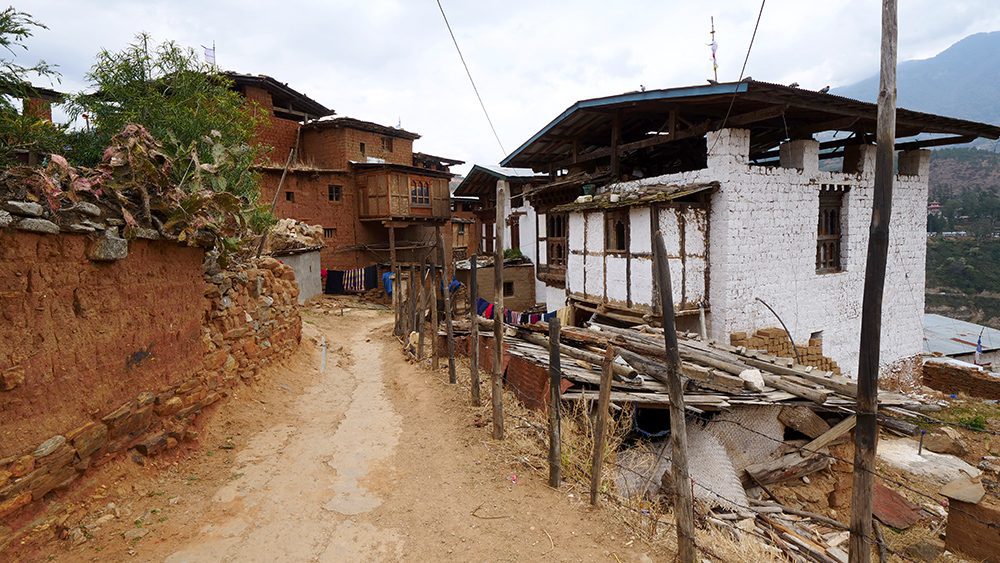
This village, thought to be one of the oldest in Bhutan, is one of the best places to get a good look at traditional Bhutanese life. Exploring it is like taking a trip back in time! I recommend taking a car to the top of the village and then making your way down the winding pathways to explore.

As you go, you’ll come across large, multi-general houses and traditional stonemasonry. A lot of the houses, which are clustered close together, have stone foundations with mud bricks on top. These are the older houses; the newer ones contain wood.
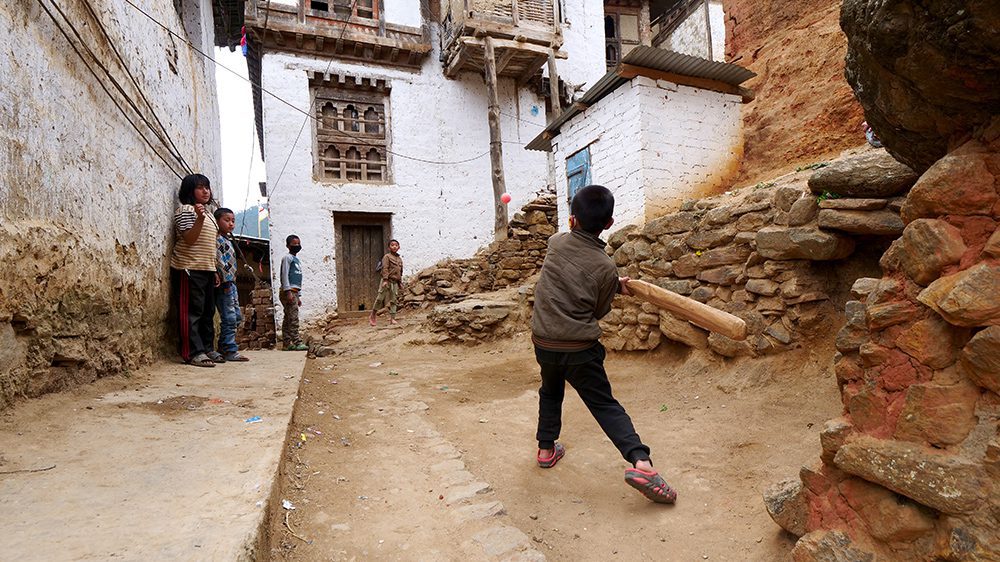
Eagle-eyed visitors may also be able to spot the beautiful Wangdue Phodrang Dzong, a fortress that stands across the river. The village’s forefather arrived from India around the time that Bhutan’s founder and unifier, Ngawang Namgyal, built the fortress in 1638.
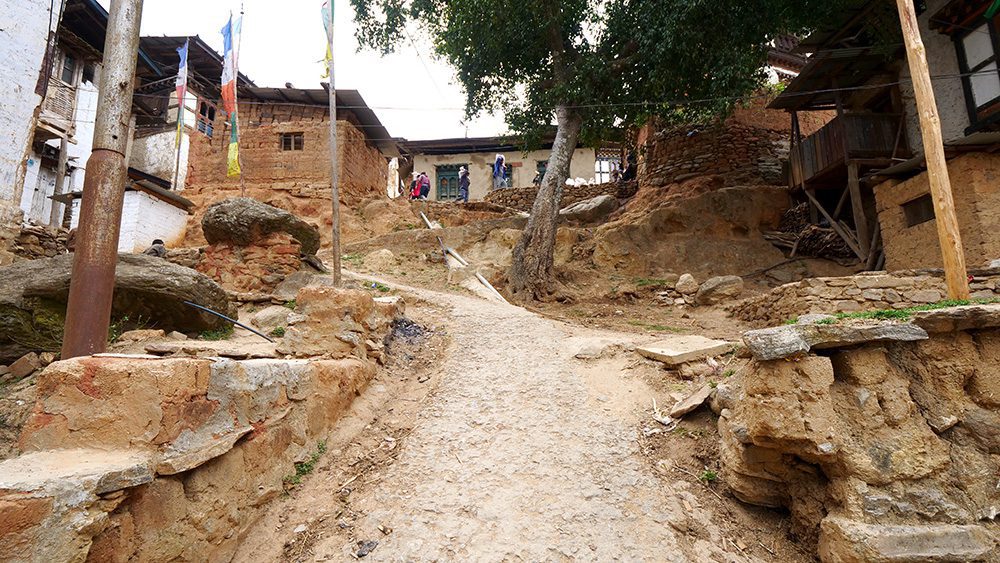
You’ll likely have to share the paths through Rinchengang with cows and dogs, who seem to roam the village freely. During my visit, I also came across a group of young kids playing cricket. It reminded me of a town I’d visited years earlier in Turkey. Keep in mind, Rinchengang is a real, functioning village. It’s not a tourist attraction. So you won’t find much in the way of gift shops or souvenirs. The gift here is getting to experience it!

While you’re exploring the Wangdue Province, I recommend visiting a second village called Rubesa. To get there, you have to follow a narrow, winding mountain road. The way the narrow road snakes its way through the mountains with sheer drops on one side, is kind of scary! The road also gets bumpier as you approach the village,
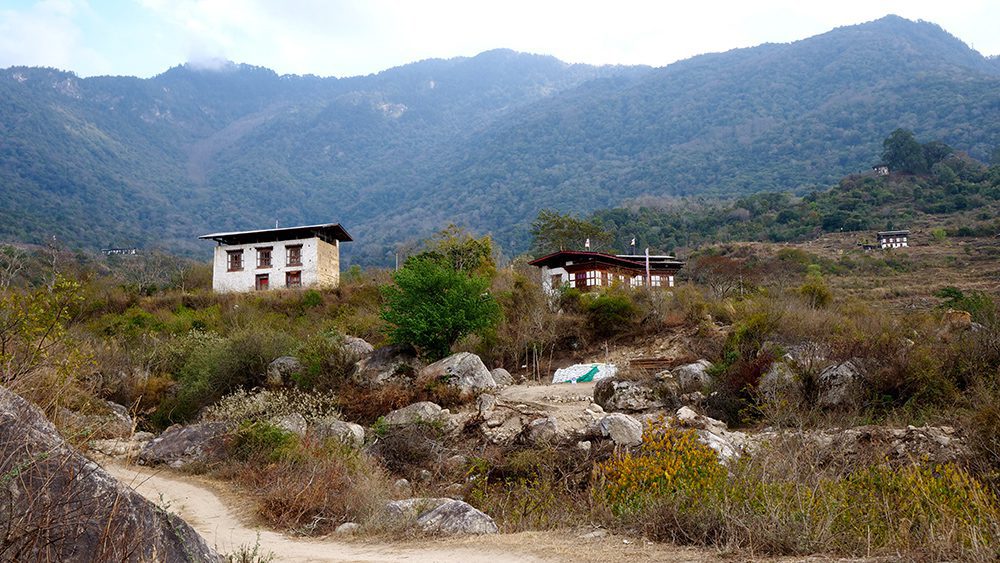
Once you arrive in Rubesa, you’ll notice that it’s quite different from Rinchengang. Here, the homes are much farther apart than the closely-clustered houses in Rinchengang. It’s quite beautiful and has a much more rural, agrarian feel.

If you explore the village with my good friend Tsheten from MyBhutan, you may have the pleasure of being invited into a local home to try some local food. There a large home with a room on the second floor that’s filled with low furniture. I suggest spreading out on the floor as it’s a bit more comfortable.
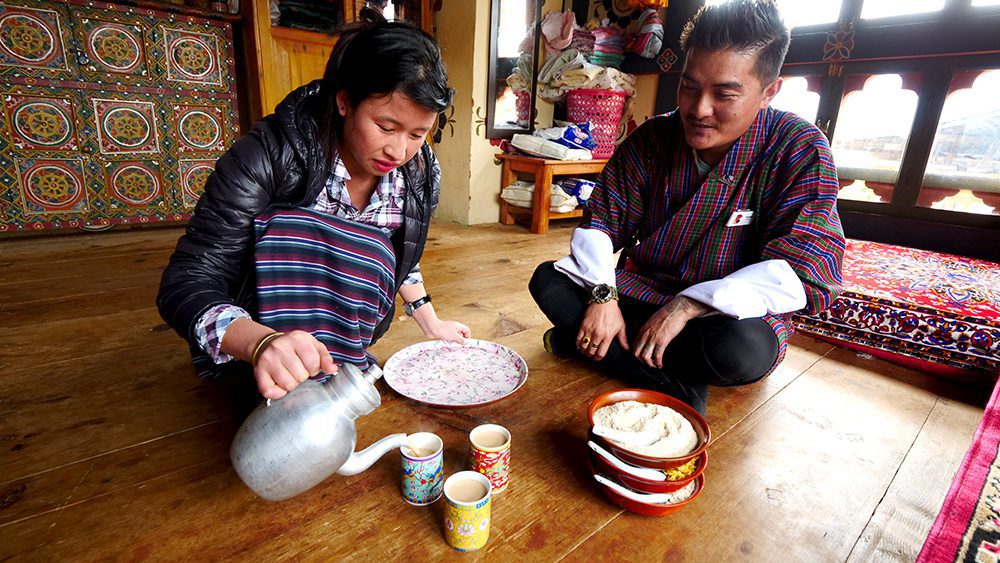
There, we met some of the friendly locals, who kindly provided us with a chai-like ngaja (milk tea) with sugar, flattened corn, flattened rice, and roasted rice power. I liked the nutty flavor of the flattened corn a lot. I learned there that locals in western Bhutan serve ngaja and suja (butter tea) to their guests, while in eastern Bhutan, they’ll serve you ara made from corn.

While you’re in town, you can try one of the local pastimes, archery. Archery is extremely popular in Bhutan in general, and playing with locals is a great way to meet and mingle with them and also get your butt whipped! I wasn’t very good at it but my guide Tsheten was able to hit the target!

But the highlight of my time in Rubesa was the visit I paid to a house down a dirt path, where local women were frying up the Bhutanese version of Indian puris, called maku. Maku and puris are both disc-shaped pieces of rice flour dough that puff up into hollow, crispy rice balls after they’re deep-fried.
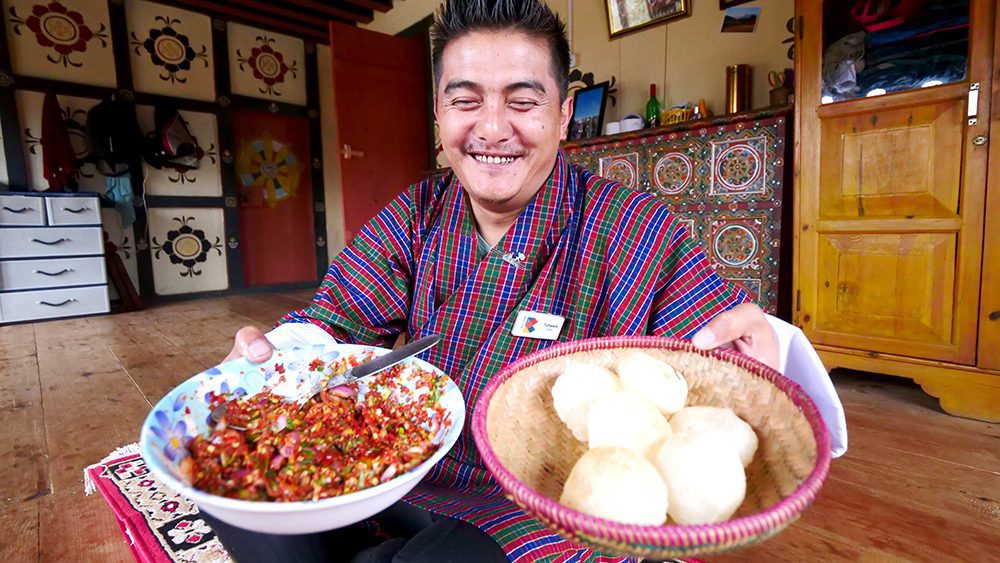
Alone, they taste similar to popcorn! And even though they’re deep-fried, they’re not oily and have an airy and crispy texture. If you want, you can buy a bag of them for 200 Nu/$2.65 USD. I recommend trying them with ara and a chili salsa with onions and tomatoes called ezay. You can either pop a hole in the maku and fill them with ezay, or break the maku in half to scoop up the maku. Beware: the ezay is extremely spicy, so Westerners may need to take it easy!
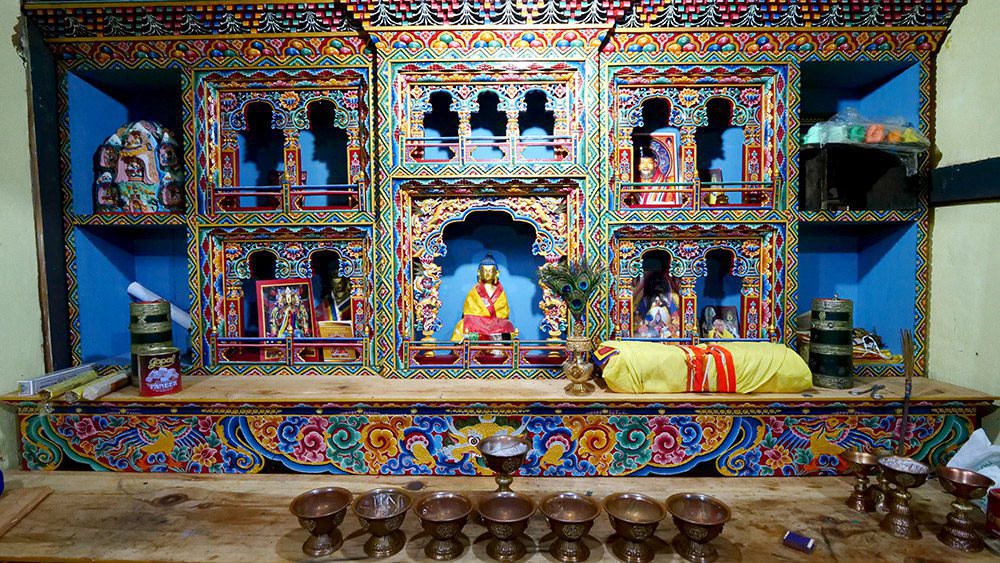
Dinnertime in Rubesa is an intensely flavorful affair. You can assist with the cooking if you’d like. I briefly cut up a few chilies before letting the woman who was preparing the meal take over—she was much better and faster than I was.

She used the chilies in a fresh and spicy ema dashti along with fresh cow cheese and processed cheese. Alongside it, I also enjoyed a creamy kewa dashti (chilies, cheese, and potatoes), red rice, a smooth and silky spinach soup, tender fried beef with chilies and cheese, and ezay. This meal is definitely one of the top things you must do in Punakha, Bhutan!
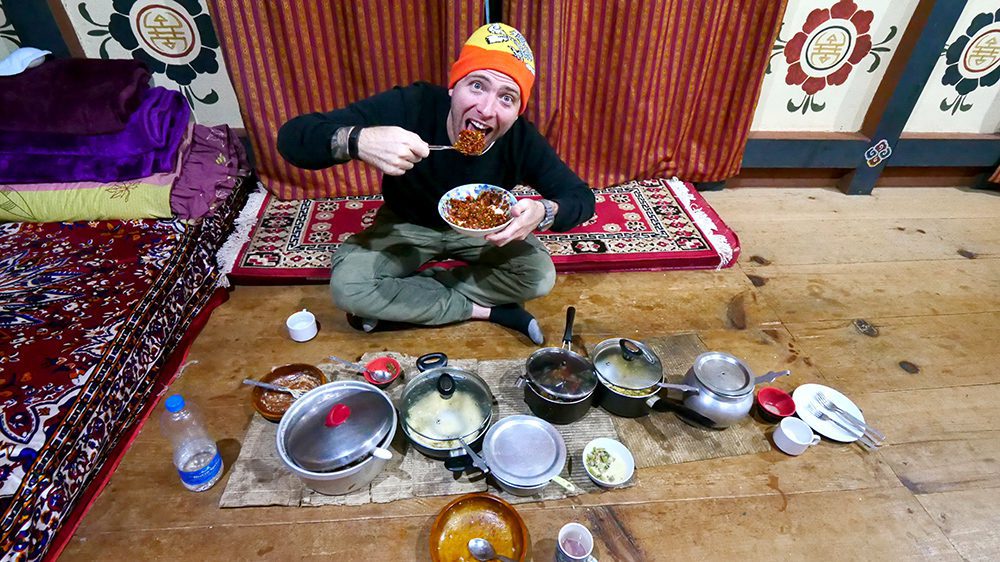
Before or after your meal, take a tour of the house. On the walls are bright and colorful paintings created by the graduates from a painting school in Thimphu. They’re incredibly detailed and are beautiful to look at. Another beautiful area of the house is the altar room, which is used for religious purposes.
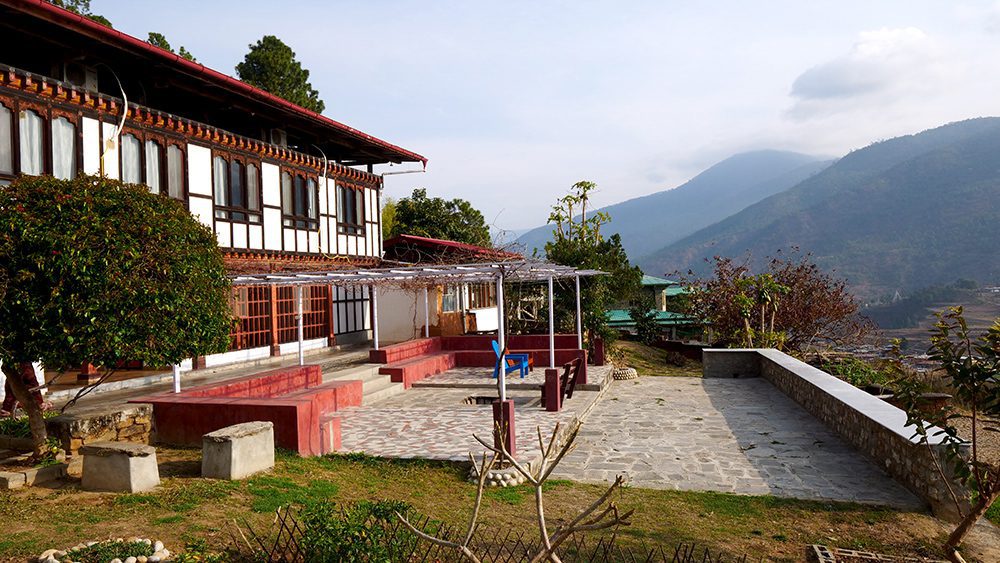
When you stay in Punakha, another fantastic accommodation is the Drubchhu Resort. This beautiful, family-owned resort is the definition of serenity, as it overlooks peaceful farmhouses and picturesque rice paddy fields. It’s also well-placed in Bhutan, located near the meeting point of the Thimphu, Wangdue, and Punakha districts.

The resort was built on the remains of a granary that was more than a century old. It opened its doors in 2014. The grounds are home to a drubchhu, or a natural spring that’s thought to have healing powers. The giant pine trees nearby are said to be the home of Nagas, mythical snake-like beings thought to live in the area.
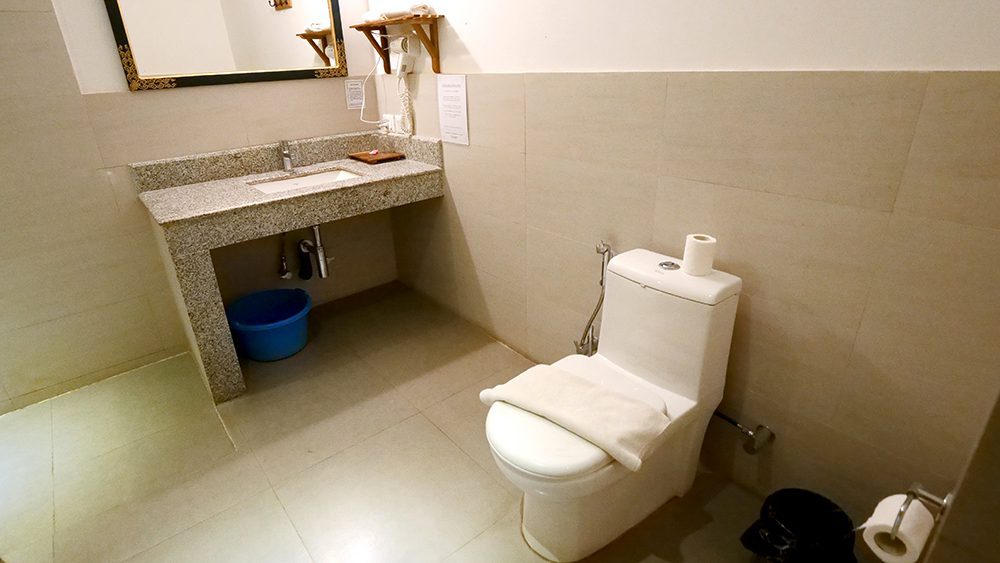
The rooms come in two varieties: Deluxe, which is larger, and Superior which is smaller. Both are quite spacious. My room was a Deluxe, which measures 458 square feet in size. Inside was a comfortable king-size bed, a desk, a flat screen TV, several seats, and a roomy bathroom with a shower, bathtub, toilet, and sink. It’s everything a traveler could want!

Drubchhu Resort boasts three great places to eat: the Ari Restaurant, Drubchhu Café, and the Mad Man bar.
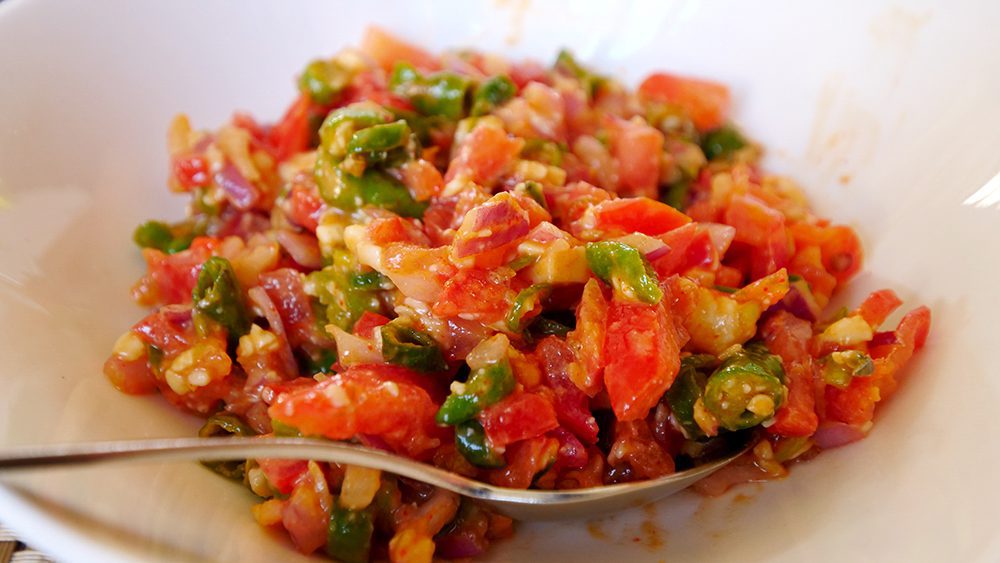
Breakfast at the resort is another spice-filled affair. I suggest trying the egg curry, fried rice, and cheesy ezay. The egg curry is basically a hard-boiled egg in a light, reddish, soup-like curry. It’s moderate on heat but full of flavor. The fried rice with chilies is fantastic with the curry. Meanwhile, the ezay adds a nice pop of heat that’s hot but not unbearable.
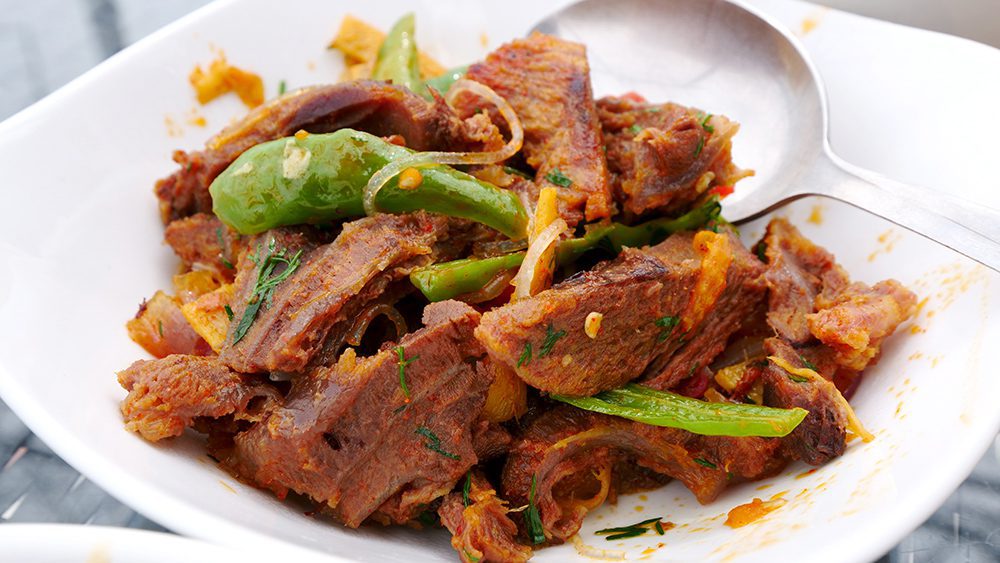
For your lunch, the best thing to do is have a picnic by the nearby river. There, I enjoyed more ema dashti made with red chilies, tough dried beef with chilies and rice noodles, Indian white rice, and cheesy cauliflower. The broth from the ema dashti was downright fiery, though the red chilies weren’t particularly hot. They only make your lips tingle a bit. The cauliflower was my favorite, though. The cheese on it was almost completely liquid but still full of flavor!
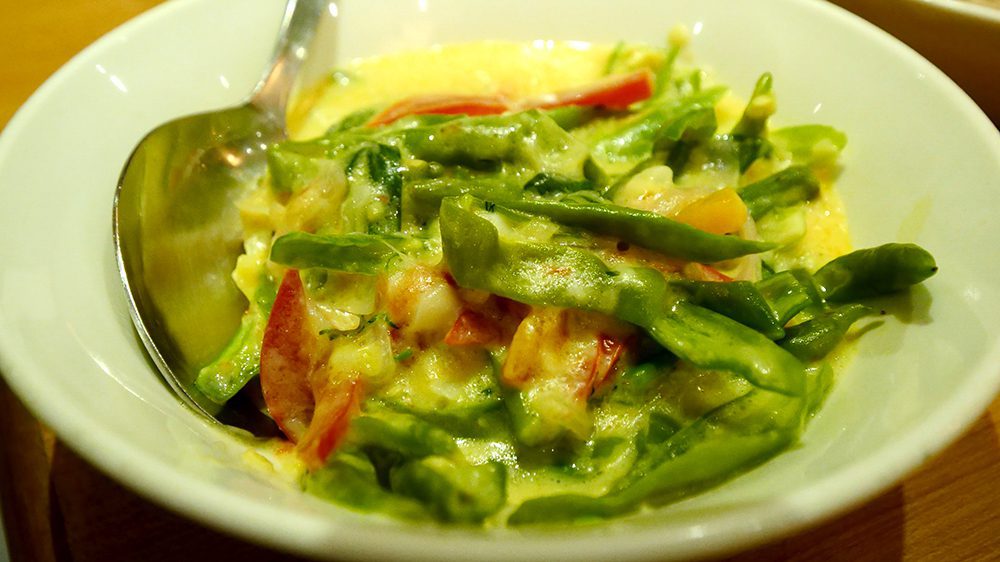
For dinner, I recommend the Ari Restaurant. Skip the buffet and go with the traditional fare. You can’t go wrong with the ema datshi. Also, try the creamy and spicy kewa dashti. It was like a fiery potato salad! There was also a thin chicken curry with chilies and onions. I also loved the light and spicy pumpkin soup with corn, onion, potatoes, and rice.
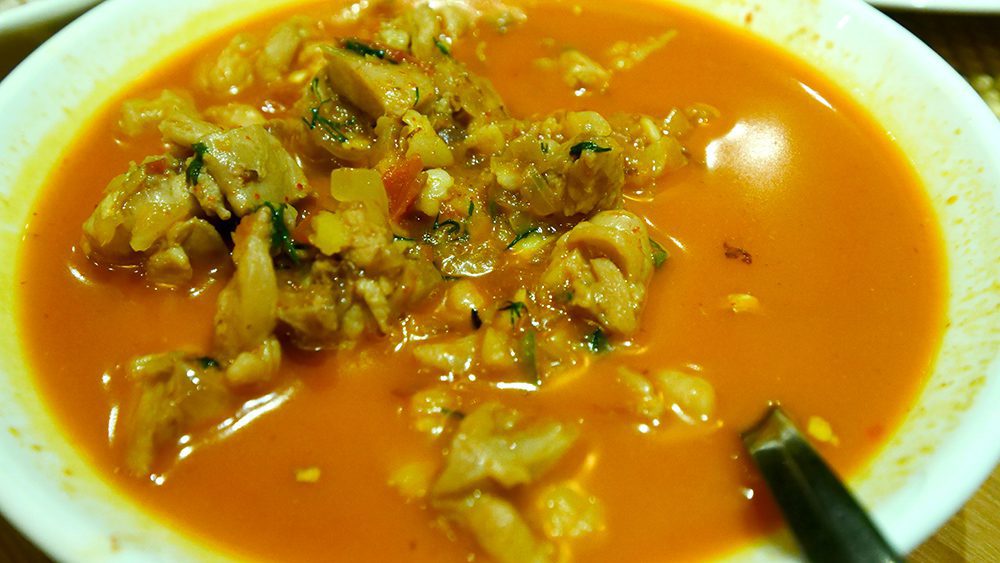
Meals like these are some of the top things you must do in Punakha, Bhutan. Bhutanese cuisine contains so many fresh vegetables that it’s easy to find vegetarian dishes in the country. The meat dishes are epic, for sure, but the vegetables are where it’s at!
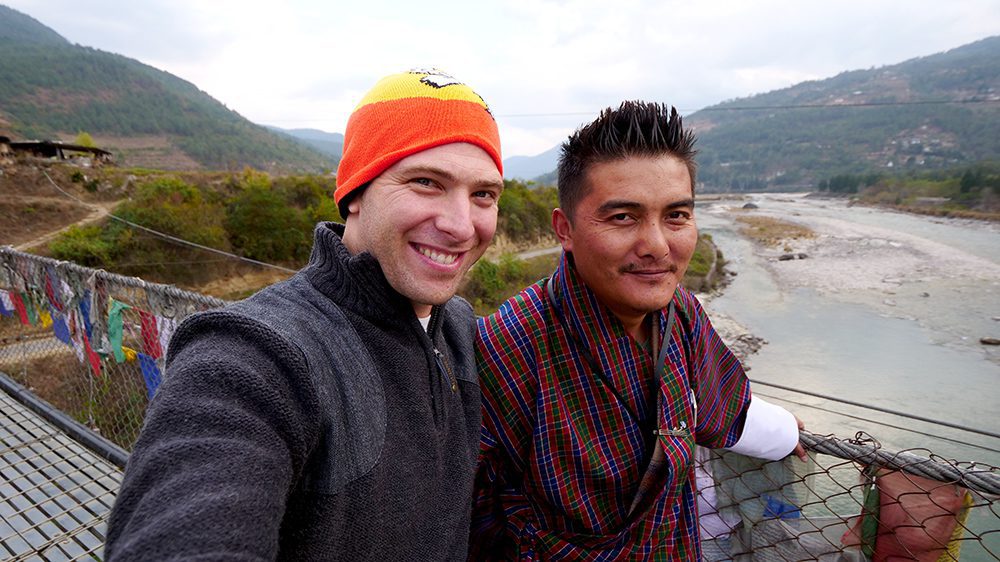
And those are my favorite things to do in Punakha, Bhutan! It doesn’t matter what kind of traveler you are—in Punakha, you’ll find something that’s for you. If you’re the outdoorsy type, the entire city is ripe with opportunities to hike and explore the beautiful, natural setting. Travelers who want to explore local culture can do so at Punakha’s festival and monasteries. And Punakha’s mix of cheesy, spicy, and meaty dishes will have you salivating. With friendly locals everywhere, I have no doubt that you’ll fall in love with this gorgeous Himalayan city. Book a trip to Punakha today to experience it for yourself!
Huge thanks to my friends Tsheten and Nidup from MyBhutan for showing me around their beautiful country!
NOTE: If you need to check the visa requirements of a particular country, click here. To apply for a visa, find up-to-date visa information for different countries, and calculate the cost of a particular visa, click here!
Counter
101 Countries • 1432 Cities